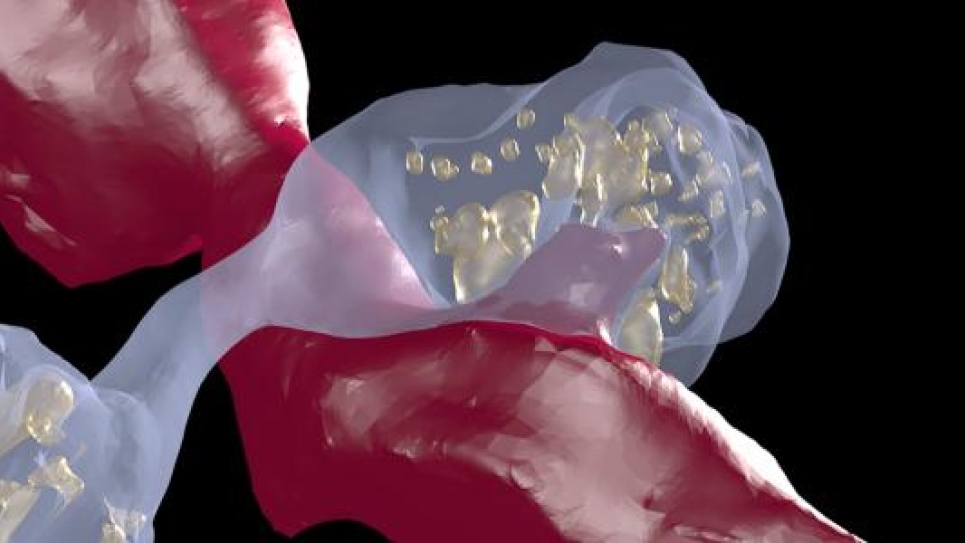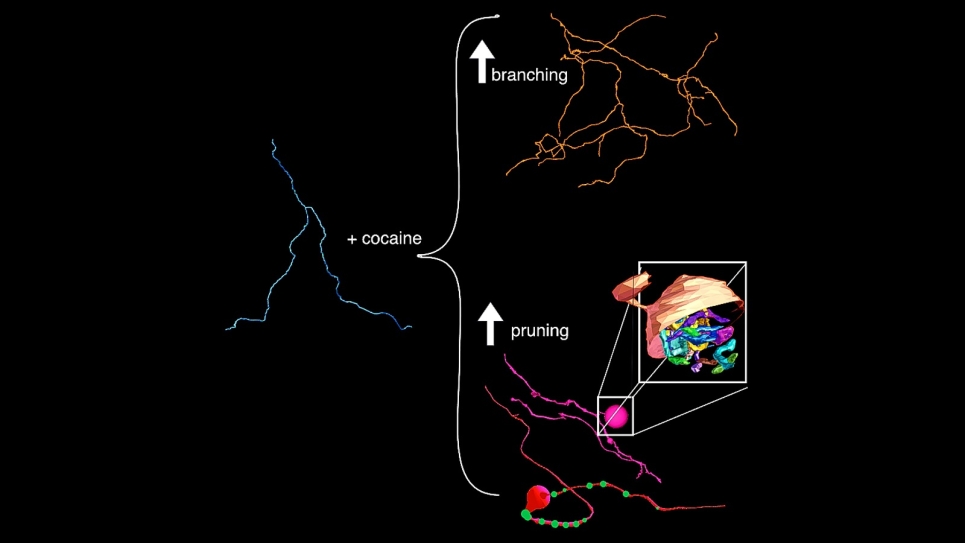Some of these swellings, they found, were devoid of any vesicles, leading some critics to charge that they could not be defined as proper release sites. These empty varicosities, they say, likely indicate that there may be other molecular components, in addition to the presence of vesicles, that define dopamine release sites.
“We suggest that it’s possible that these empty varicosities have all the molecular machinery to release dopamine, but it may be that dopamine vesicles are being shuttled actively throughout the axon and we just happened to catch a snapshot in time where some are empty,” said Wildenberg.
The cocaine portion of the study yielded two major changes, both of which focus on axons, the ultrathin cables that project from neurons. Like trees, axons sprout tendrils that branch away toward other axons to deliver signals. After exposing the mice to cocaine, the team found an increase in that branching.
In a totally unexpected result, they also found that about half of the axons they studied formed huge swellings, or bulbs, at various locations along the axon. The nearest correlation to these bulbs appears in developing animals, at junctions where neurons meet muscle. In some cases, an axon retracts, or is pruned, and then swells up into a large bulblike structure.
The team saw signs of both sprouting and retracting, sometimes in the same axon. According to the researchers, the finding represents the first documentation of this behavior happening in the context of a disease model.
“Now we know that there is an anatomical basis to drugs of exposure,” noted Kasthuri. “These animals received one or two shots of cocaine and already, after two to three days, we saw widespread anatomical changes.
“It’s not like some molecules are changing here or there,” he added. “The circuit is rearranging much earlier and with much less exposure to the drug than anybody would have thought.”
While the study has helped elucidate questions of form, function and dynamics in the dopamine system, it also presents important new questions related to repeated exposure and addiction, as well as treatment and recovery.
Primarily, can the brain overcome the structural rearrangements introduced by addictive drugs, based upon its plasticity in other areas? Results from this research and accessibility to powerful tools of discovery hold the key to answering these types of questions in the future.
Research presented in this article was published in the Dec. 29, 2021, issue of eLife under the title, “Cell type specific labeling and partial connectomes of dopaminergic circuits reveal non-synaptic communication and large-scale axonal remodeling after exposure to cocaine.”
Authors include: Wildenberg, Kasthuri and A.M. Sorokina, University of Chicago and Argonne National Laboratory; J.L. Koranda, A. Monical, C. Heer, M.E. Sheffield, X. Zhuang and DS McGehee, University of Chicago.
Funding for this research was provided by a technical award from the McKnight Foundation, an NIH BRAIN Initiative grant, and an NSF NeuroNex grant.
==========
The Argonne Leadership Computing Facility provides supercomputing capabilities to the scientific and engineering community to advance fundamental discovery and understanding in a broad range of disciplines. Supported by the U.S. Department of Energy’s (DOE’s) Office of Science, Advanced Scientific Computing Research (ASCR) program, the ALCF is one of two DOE Leadership Computing Facilities in the nation dedicated to open science.
Argonne National Laboratory seeks solutions to pressing national problems in science and technology. The nation’s first national laboratory, Argonne conducts leading-edge basic and applied scientific research in virtually every scientific discipline. Argonne researchers work closely with researchers from hundreds of companies, universities, and federal, state and municipal agencies to help them solve their specific problems, advance America’s scientific leadership and prepare the nation for a better future. With employees from more than 60 nations, Argonne is managed by UChicago Argonne, LLC for the U.S. Department of Energy’s Office of Science.
The U.S. Department of Energy’s Office of Science is the single largest supporter of basic research in the physical sciences in the United States and is working to address some of the most pressing challenges of our time. For more information, visit https://energy.gov/science.

